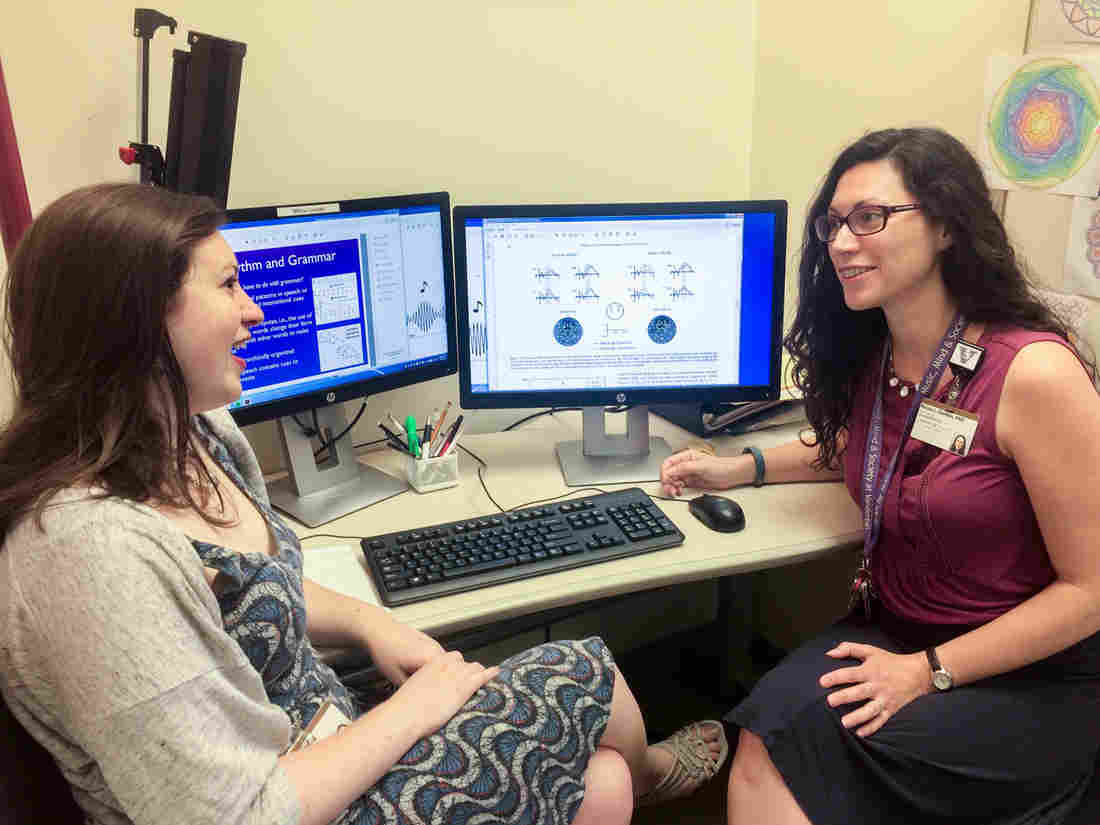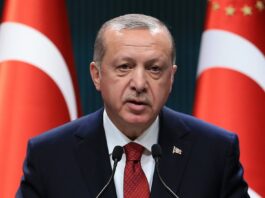

Research analyst Allison Aaron and Assistant Professor Reyna Gordon are studying how music and rhythm training could help children who struggle with language development. Their work is part of Vanderbilt’s Program for Music, Mind and Society. Kacie Dunham/Courtesy of Reyna Gordon hide caption
toggle caption
Kacie Dunham/Courtesy of Reyna Gordon
Research analyst Allison Aaron and Assistant Professor Reyna Gordon are studying how music and rhythm training could help children who struggle with language development. Their work is part of Vanderbilt’s Program for Music, Mind and Society.
Kacie Dunham/Courtesy of Reyna Gordon
Reyna Gordon was an aspiring opera singer fresh out of college when she began contemplating the questions that would eventually define her career.
“I moved to Italy when I finished my bachelor of music, and I started to take more linguistic classes and to think about language in the brain, and music in the brain,” she says. “What was happening in our brains when we were listening to music, when we were singing? What was happening in my brain when I was singing?”
Those questions led her to a graduate program in neuroscience in Marseilles, France.
Today, Gordon is director of the Music Cognition Lab in the Department of Otolaryngology at Vanderbilt University Medical Center. She studies the connections between rhythm and grammar, and how rhythm and music training might help children with atypical language development.
Gordon has previously published research showing a correlation in children between good rhythm skills and a good grasp of grammar. She found children who can detect rhythmic variations in music have an easier time putting sentences together.
“One thing that rhythm and grammar have in common is that they both unfold over time, and our brains form expectancies about what’s coming up based on what we just heard,” says Gordon.
Consider the following sentence: The boy read the book that his mother gave to him. “When we hear ‘The boy read,’ then we’re expecting an object after that,” Gordon says. “Then when we hear ‘The boy read the book that,‘ then we’re expecting an additional clause – something else about the book.”
By age 5, Gordon says children typically understand and use complex sentences. But studies have shown that about 7 percent of children have what’s known as specific language impairment or developmental language disorder, which hinders their language skills even though they have IQs in the normal range and don’t have autism or hearing impairment.
It often goes undiagnosed. “They have some grammar, but they haven’t acquired it at the same rates as their peers,” Gordon says. “So expressing complex ideas, especially as they start to go through school, is difficult.”
In her lab, Gordon studies children with and without language impairment. Some of the kids might already be seeing speech therapists. Gordon wants to see if, in addition, music and rhythm training can help them.
On a recent afternoon, 7-year-old Adalyn Patel paged through a picture book with research analyst Allison Aaron, who asked her to describe what she saw and offered prompts.
“The dog ran to the door and was barking,” Aaron said to Patel. “What does the boy think? Start with ‘He…'”

(From left to right) Mackenzie Stamper, Adrian Rodriguez and Luke Ryan attend weekly Suzuki violin lessons with instructor Sara Johnson, part of a training program called MILEStone, or Music Impacting Language Expertise. Andrea Hsu/NPR hide caption
toggle caption
Andrea Hsu/NPR
(From left to right) Mackenzie Stamper, Adrian Rodriguez and Luke Ryan attend weekly Suzuki violin lessons with instructor Sara Johnson, part of a training program called MILEStone, or Music Impacting Language Expertise.
Andrea Hsu/NPR
Patel answered, “He thinks the dog is barking at something that’s, that’s not there.” A child with atypical language development might answer the same prompt with just a couple of words.
In one rhythm test, kids listen to several musical rhythms and say whether they are the same or different. In another, they mimic a string of spoken syllables, with variations in timing and intonation.
Gordon and her team invite families of children who show weaknesses in these assessments to take part in a training program called MILEStone, or Music Impacting Language Expertise. It’s a 5-month program the lab created that involves weekly Suzuki violin lessons and a weekly movement class.
“There may be something that music training can do to help boost things. Maybe we’re able to boost their auditory processing skills in the brain, or something about their rhythm sensitivity in their everyday listening to language, ” Gordon says. “We don’t know yet, so we actually have a whole series of questions to look at. And while we’re in these initial stages I think that music is a fun thing, and if the families are enjoying it, it’s a good program to do.”
Gordon and her colleagues plan to present some initial findings from their research at a conference on music, sound and health in Boston this summer.














